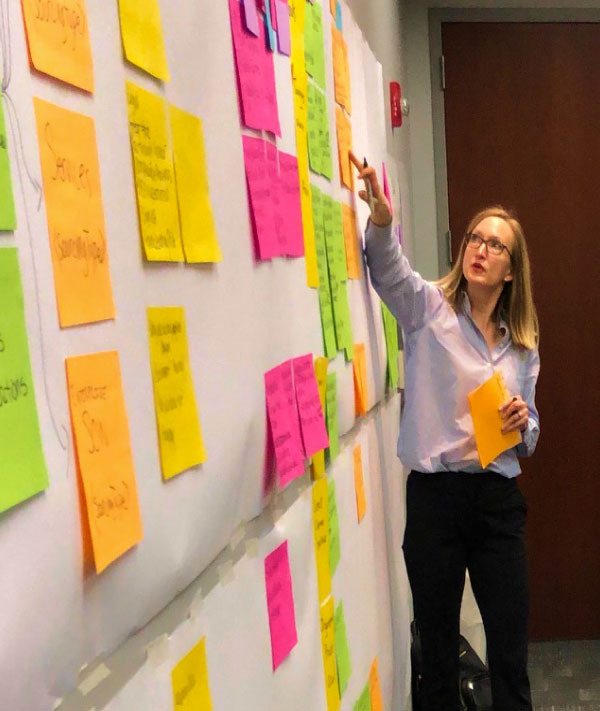It is often said that software development and knowledge work is invisible work.
But as a leader, if you do not see it, how can you improve it? ‘Going to the Gemba’ is one method.
Gemba is a Japanese word for the ‘real place’ – the place where the value-creating work occurs. To understand the issues that affect a process, it is critical to go to the Gemba and see what is happening. James Womack provides inspiring and detailed guidance on this important management method in his book Gemba Walks. Taiichi Ohno, considered the father of the Toyota Production System, is credited with originating the technique and his quote epitomises the methodology: “go see, ask why, show respect.”
There is a wealth of information about how to conduct a Gemba Walk in manufacturing, but comparatively little is published about how to do one in the software industry. So, we have developed our own techniques to help ‘see’ the invisible work in technology enterprises. This blog post shares some guidance you can leverage.
What is a Gemba Walk?
When ‘outside’ people who don’t live the process – including managers who don’t do the day-to-day work – intentionally and directly study a work environment, they can start to ‘see’ root causes of performance problems that would otherwise go unnoticed.
In a Gemba Walk, leaders visit the work area to glean first-hand knowledge regarding:
- How products are built
- How services are provided
- Current challenges
- Opportunities for improvement.
The goal is to examine the current state of a process by observing it, in action, where it occurs. This aim is narrow, focused, and very specific. Yet the purpose is to give leaders a holistic view on how to create improvements across the full value stream. It’s about trying to uncover how valuable, available, adequate, flexible, and waste-free each process is, and whether value flows smoothly between steps.

We recommend that you outline a high-level blueprint of the value stream from customer request to the delivery of value. Identify the manager for each area of work as well as employees who perform the work, for observation purposes.
Try to schedule Gemba Walks in the order of the value stream OR the backwards order of the value stream. It is not as impactful to do the visits out of sequence or on a standalone basis. Your goal should be to optimise the full value stream.
The Gemba should be viewed in the actual work environment. For example, if people enter forms, observe them entering forms; if they are coding, observe them developing; if key meetings take place, observe their meetings. Unlike a manufacturing line, this means Gemba Walks may need to take place over several days as opposed to a single day.
How to Conduct a Gemba Walk?
In traditional manufacturing value streams, it made sense for the full management team to walk down the manufacturing line. However, in knowledge work, it can be very disconcerting for employees to have a large group of people observing them. Therefore, we recommend no more than three people participate. Invite relevant value stream managers and leaders, or external consultants, to join you, depending on your goals.
Ask in-depth questions about the process being observed to get a high-level understanding of what is being done to transform an input into an output. It’s useful to prepare specific questions designed to gain insight into any problems that need to be resolved.
If your Gemba Walk is performed remotely, be sure to use a videoconferencing tool that enables the person you are observing to see your face clearly. Prepare the participant by letting them know that you will be asking them to screen-share during your session. Remote Gemba Walks can be very effective if they are prepared adequately in advance. One remote Gemba we conducted involved a software engineer. We advised him that we would want to see his entire
work screen in advance, so that he would not be caught off guard.
As a result, we saw that he was interrupted multiple times by numerous people through a messaging app. The messages were in all capital letters, stating an urgent issue needed to be addressed immediately. These interruptions left him unable to focus on addressing the actual issue. We also observed that the tracking for all work was in his email, not through a ticketing tool. This meant he had to sort through lengthy emails for the needed documentation and history. We respectfully paused our Gemba so he was not distracted by us. The point is that these observations would not have been made remotely if we were only talking to the person about his work.
Preparing for Going to the Gemba
There are seven key points to bear in mind before a Gemba Walk:
- Ensure your plan has been communicated to employees, most likely through their managers. It is important that they understand the objective and the spirit of the visit.
- Prepare the questions you will want to ask and a format for taking notes.
- As a pair or triad, establish roles: who will ask questions and take notes, will you alternate asking questions, will one person lead, etc.
- If there are significant time zone challenges, respect the employee’s time zone over your own.
- Ensure your mindset is to observe and study, not to provide suggestions and demonstrate your knowledge. You are seeking their knowledge. Be humble.
- Read and study all notes, details, and documents about the process you are observing before you arrive.
- If you are going in person, you will likely end up sitting in people’s cubicles. Limit the items you plan to bring so that you do not overwhelm their personal workspace
In addition, plan to take notes manually so you don’t have a computer barrier between you and the person you are interviewing and observing. If you are in a remote meeting this will help you focus on the employee’s face and maintain eye contact. People will warm up more easily when you are listening and asking follow-up questions as opposed sitting behind a computer monitor or looking away and typing loudly. Err on the side of listening rather than capturing detailed notes. If you feel that the rapport is ok, it may be absolutely fine for one of you to take notes on your computer to be faster/more complete and still have the people you are visiting be open and honest with you. However, plan on not taking notes on your computer and build in time to write detailed notes after the meeting when your mind is fresh.
When you open the Gemba session, introduce yourself and explain why you are there. Remember that this is a very awkward experience for most people. Do everything you can to make this as natural as possible. Work hard to be friendly, establish rapport, and build trust. Be empathetic. Explain why you are there and the goals and benefits you are hoping to be able to support (without making any promises). People may be worried that you are judging them or evaluating the importance of their job. Make it clear that the intent of the Gemba Walk is to understand the full system and how it operates holistically, not to evaluate any one person’s performance. This will help put people at ease so you can enjoy the benefits of deep insights to improve how work is done at your company.
Robin Morrison is the Head of Cloud Solution Offerings at Sourced. Her goal is to be a thoughtful, fearless leader that disrupts non-value producing activities and recreates a system focused on creating value. She helps solve problems in technology-focused companies by looking at how process change can positively impact an organisation and its people. Working with clients in multiple industries, across the globe Robin uses both agile and lean techniques to help leaders improve the quality and speed of their software development life cycle, often utilising Gemba Walks to provide targeted recommendations.




